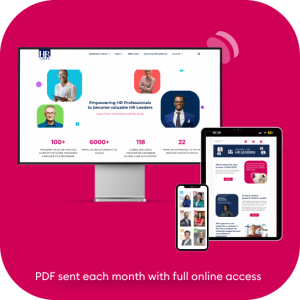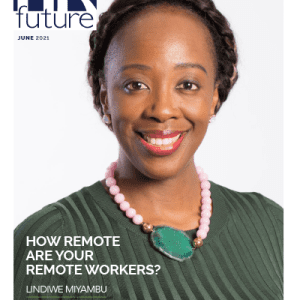The landscape of Human Resources (HR) is undergoing change and development. Even the term ‘Human Resources’ has in some cases been redefined with terms like People Operations or People & Culture emerging, a reflection of the new, exciting era of HR.
In this dynamic profession, the three main challenges and changes that HR can expect:
- Attracting the right talent: Access to skilled workers is a critical factor that sets successful companies apart and as a result competition for talent is fierce. Organisations are initiating perks like remote work, utilising the gig economy, and reinforcing the pull-factor of their values to attract and retain the right talent. They are also relying more heavily on data and HR analytics for decision-making around their talent recruitment and management.
- The widening skills gap: With innovations in technology and the workplace taking place at a rapid rate, and business leaders seeking to digitise operations, many HR leaders are struggling to fill the widening skills gap in the available workforce. According to recent Gartner findings, 64% of managers do not believe their employees can keep up with future skills needs. Additionally, 70% of employees say they have yet to master the skills needed to do their jobs today, let alone master future skills. Employee development forms part of most HR professionals’ strategy to solve this.
- Improving leadership development: With more baby boomers retiring and taking their skills and expertise with them, investment in leadership development programs is a priority for most HR managers and executives. According to Forbes we have entered the age of millennial management, with 30 being the average age of first-time managers and millennials holding 30 percent of managerial-level roles. A variety of surveys show that millennial managers value learning and development experiences more than previous generations, making investment in effective leadership development a key priority.
With these challenges being a reality for the foreseeable future, HR professionals are positioning themselves towards readiness for what is to come in the workplace, particularly in the realms of HR technology, millennial management, and a rising remote workforce.
Here is what to expect in the New Era of Human Resources.
1. Greater use of HR Analytics
HR analytics is not a new notion for HR professionals, as LinkedIn’s recent research shows. With triple the amount of HR professionals in the U.S. listing analytics skills on their profiles over the last five years, HR analytics – and knowledge of how to use analytic tools – is a key skill for people in this profession.
Simply put, HR analytics explains business phenomena by utilising people data. It is essentially a data-driven, evidence-based strategy to identify and analyse people-related issues to provide tangible measures and objective recommendations to decision-makers.
Most HR teams have decades-worth of data at their disposal, but very few have put that data to good use. Most commonly this is due to the data being stored on siloed, non-communicative platforms that hinder the integration and amalgamation of data with analytic tools (like Sage 300 People). Most HR managers assume that the use of metrics such as absenteeism, staff attrition or overtime is sufficient. However, it is not enough if the objective is to provide the business with measurable ROI based on objective data analysis.
“Nothing matters unless you can prove it. HR makes mistakes by focusing on a metric and not tying it into the business. For instance, you can’t assume higher engagement leads to less turnover. You have to demonstrate it.” – Greta Roberts, CEO of Talent Analytics Corp
When HR leaders leverage these analytics, it leads to better working environments for employees and improved profits for the organisation. Use these example questions to determine if your HR team is utilising HR analytics effectively:
- What is your annual employee turnover?
- How much of your employee turnover is made up of regretted loss?
- Which employees are most likely to leave your company within a year?
These questions can only be answered by analysing data. Where the first question may be easier to answer, the second requires a combination of data from your HR Information System (HRIS) and your performance management system. The third question requires even more data and greater in-depth analysis. A system that captures data and processes it seamlessly will give you the tools you need to ensure you have a productive workplace.
2. Upcoming HR technologies
With the emergence of new technology, tools, systems, and infrastructures bringing the promise of greater value and efficiency, here is a short list of up-and-coming HR technologies worth watching.
Robotic Process Automation (RPA)
RPA is an application of technology, governed by business logic and structured inputs, aimed at automating business processes, according to CIO magazine. RPA tools support data-driven processes and enable automation of transactions and data manipulation by triggering responses and communicating with other digital systems.
For the HR professional, RPA can automate repetitive tasks and free up HR teams to focus on what is more important. For example, instead of manually updating the applicant tracking system after a new hire, making a new employee record on the employee database, gathering employee documentation, and even double-checking HR compliance, RPA can do it all for them.
Artificial Intelligence (AI)
It has lately been said that data is “the new oil.” This is because data is what drives businesses and is the lifeblood of machine learning (ML) and AI. What is AI? A simplified definition would be that AI is a computer algorithm that takes provided data and, after interacting severally with that data, is able to perform a task or come to a conclusion beyond what it was coded or taught to do originally, without human intervention.
AI is capable of processing vast amounts of data at an exponentially higher rate than people can ever hope to do. AI serves to provide insight, predictions, analysis, and actionable strategies based on multiple sources of data.
“The future is going to be centred on the employee experience and taking engagement down to the individual level. There is no way we can do that on any scale without applying the best that ‘data science’ has to offer.” – Richard Hughes, Senior Vice President at UnitedHealth Group
Most AI applications used in an HR environment today are geared towards improving the recruitment process. They reduce recruiting timelines and assist in candidate screening, lowering the need for expensive man-hours and resources to do so, effectively reducing the total cost of acquisition of new talent. AI can also forecast seasonal demand and notify HR professionals when they should start hiring people for a certain department to cater for an increased workload.
3. Millennials and new work
Born in the digital age, tech-savvy millennials value digitalisation in all its forms, embrace and often initiate change, and now make up the majority of the workforce. This is great news for organisations looking for new ideas to improve operations, stay relevant and gain a competitive edge.
What do Millennials want?
Millennials want different things than their less-demanding predecessors – the stoic Baby Boomers. To attract and retain the tech talent and skills they bring organisations are doing what they can to accommodate these changes:
- Flexibility: With a strong desire for work-life balance, millennials are attracted to organisations that offer flexible working arrangements, such as remote work and flex hours.
- Communication: Collaboration, transparency and feedback are important to millennials, particularly if it leads to learning.
- Strong values: Millennials are invested in supporting the greater good according to recent research by Deloitte. 75% of surveyed millennials believe businesses are not doing enough to drive positive societal impact.
New work calls for new leadership
More organisations are subscribing to the notion that it is more important for employees to demonstrate that they are able to do the work, have the right values, and are committed to ongoing development than if they are in possession of an outdated degree that they earned years ago. This is known as ‘new work’ and is the future of the workplace. It is no surprise that these characteristics are strongly aligned with most millennial workers’ approach to work.
Likewise, new leadership trends are in keeping with this, promoting self-management, empowerment, teamwork, agile processes, and emotional intelligence, to name a few.
- Empowered autonomy. Employees are given the freedom to self-manage within a framework of clearly defined goals and desired outcomes against a structured set of rules. This is shown to improve employee productivity and satisfaction. According to Harvard Business Review (HBR), millennials in Africa seek managers who empower their employees to do the job at hand above all else.
- Gig economy. The gig economy is a type of labour market that is based on short-term contracts and freelancing as opposed to the more traditional permanent contracts model. The gig economy gives employees flexibility to choose which jobs they perform, provides unparalleled lifestyle benefits and autonomy, as well as giving opportunities to learn new skills while being paid. In the U.S. one third of their entire workforce – over 57 million workers – are part of the gig economy. HR professionals are seeking new ways to keep their workforce agile, engaged, and efficient in an attempt to manage the transition from a long-term employment model to short-term freelance contractors. Subsequently, software and tools that support employee engagement, employee self-service, staff monitoring, onboarding and offboarding are taking centre stage.
4. Focus on employees
The mantra ‘our best product/asset is our team’ is truer than ever before. Employees are rich in first-hand experience of your company’s culture, structures, systems, products, and services. Not only can they tell what your customer wants, what works and what does not, they also have the power to accelerate or derail critical processes and innovations your organisation requires to stay competitive. As a result, HR professionals and executives are doing what they can to improve employee experience, engagement, and development.
Employee experience
The “employee experience” begins at the recruitment and onboarding phases, continues through the performance management and development phases, and terminates at the offboarding phase.
Understanding and enhancing the employee experience life cycle should be a critical deliverable of every HR department as it can lead to tremendous benefits for both the employee and the organisation when managed well. These benefits include:
- Increased employee well-being.
- Reduced sick leave.
- Greater employee retention.
- A dedicated workforce committed to driving sustainable growth.
- A strong employer brand, improving your organisation’s ability to attract talent.
Employee engagement
Gallup describes engaged employees as those who are involved in, enthusiastic about and committed to their work and workplace. Unfortunately, fewer than one-third, or 31.5%, of employees in the U.S. feel “engaged” at the office, according to a recent Gallup survey. Why does engagement matter? The 18% of actively disengaged employees cost organisations over $500 billion annually of lost productivity in the U.S. alone.
Alternatively, employees who do feel engaged bring the following benefits:
- Higher quality of work delivered;
- Higher staff retention / lower turnover;
- Greater productivity;
- Increased profitability;
- Lower absenteeism; and
- Increased employee loyalty.
Employees, particularly millennials, need to feel that their relationship with the company they work for is meaningful. This is not unreasonable, considering that on average they spend over 90,000 hours of their life working.
Recent Salesforce research shows that when companies lead with their values and seek to make a positive impact on the world around them, they are better positioned to boost employee engagement and productivity, and win the war for talent.
Employee development
The World Economic Forum estimates over one billion people globally will have to be reskilled in the next decade as a result of the emergence of new divisions of labour between humans, machines and algorithms.
The most effective way for HR leaders to help employees keep pace with changing skill needs is by implementing skills development programs that produce what Gartner calls “connected learners”. This process requires the HR professional to be responsible for skills identification, employee motivation and learning solutions.
According to Gartner, connected employees bring the following benefits:
- 25% faster to learn skills;
- 2x more likely to stay in the company;
- 66% more engaged; and
- 8x more likely to be high performers.
However, in spite of the clear benefits of and growing need for a reskilled and an up-skilled workforce, many organisations have been slow to deploy employee development initiatives due to budgetary constraints, lack of employee time to participate in training, and lack of appropriate training technology.
HR professionals responsible for learning and development are utilising the many affordable online learning platforms geared to equip working employees with the new or updated skills they need, without disrupting their workload. Additionally, unlike other generations, most millennials believe it is up to them, rather than the employer, to take care of their training and development. This short-term, iterative approach to learning, rather than a once-and-done strategy, is a more effective way of keeping up to date with the latest skills and technologies.
5. A Remote and Dispersed Workforce
Since the pandemic, people have been talking about remote work as “the new normal” and understandably so, as remote work was a key enabler of business and economic continuity during the various stages of lockdown. In short, because what employees do is more important than where they do it, many organisations now believe that location is irrelevant for work to take place.
According to Gartner’s recent CFO survey, there is a shift in favour for those who wish to continue to work from home on a more permanent basis. Many business leaders are supporting this, as even amidst a global crisis, employees reported greater productivity and higher job satisfaction when working remotely, which has translated into greater profitability for their employers.
However, remote teams and dispersed employees bring their own set of new challenges. HR professionals are now faced with the challenge of finding ways for managers to effectively support their dispersed workforce.
Common challenges of remote work
Managing personnel remotely is vastly different to managing in-office employees. Challenges inherent in remote work include:
- Lack of in-person interaction. The reduced access to managerial support and communication experienced by some remote employees can cause a feeling of disconnect or lack of support in getting their work done. According to HBR, loneliness is one of the main complaints of remote workers with more extroverted employees missing the informal social interactions typical in an office setting. Many successful remote managers establish a daily call with their remote employees, be it one-on-one or a team call, depending on the nature and role of the employee, to solve this.
- Lack of access to information. If organisations are not equipped with cloud-based or cloud-enabled business solutions that allow for anywhere, always-on access to business data, it can cause undue delays and frustrations. Employees need to have access to their workplace resources outside of the office. With many cloud-based business solutions available, this is easily solved. Leading organisations are also making HR tools available to employees and managers that provide remote access to internal processes such as applying for leave or requesting training.
- Distractions at home. Even in normal circumstances family and home demands can disrupt work. Covid-19 has made the world more open-minded about these distractions for remote workers, particularly during online video meetings. Modern managers are taking this into consideration for their newly fulltime remote teams.
- Different hours. When teams are dispersed geographically their work cannot be contingent on a location or a time zone. Additionally, some remote employees prefer to schedule their work outside of normal working hours for a more peaceful, focused environment. Asynchronous communication tools such as email, Slack, google doc comments, and recorded videos ensure a transparent, continuous flow of information sharing, regardless of date or time.
- Results-based tracking. Traditionally, managers measured employee activity, such as arriving early and leaving late, rather than true accomplishment and productivity. For remote workers, successful managers focus on outcomes, deliverables, learnings, and other measurables. This empowers employees to prove their productivity, with or without local supervision.
Final thought: to master the future you must master your data
In these uncertain times one thing is clear: putting data to good use will give you better insights into your organisation’s employee experience, engagement, and development. Developing a data-centric, tech-empowered plan now rather than later will ensure you stay ahead of the curve and address people-centric problems before or as they arise.
A good place to start is to ensure your organisation has a system that allows you to collect and store all your data in one place, removing dependencies on spreadsheets and outdated, non-communicative systems.
HR software like Sage 300 People eases the burden of time-consuming, manual tasks and provides a central place for unified business data and quick analysis. These solutions give HR professionals the much-needed freedom from manual admin to focus on improving productivity and efficiency in their core functions, particularly in employee engagement, development, and retention.
As more HR personnel begin to rely on data and systems, the more the employees they are responsible for will reward them with increased productivity and loyalty. To unlock these benefits, look for a solution that is easy to use and quick to deploy, and an implementation partner who understands HR technology and your business. With that powerful combination you can confidently face and embrace this new, exciting era of human resources.
Ronel Swart is an HR and Payroll specialist with over 23 years’ experience in HR technology. Ronel heads up the national team of HR specialists at Times 3 Technologies (T3T), a South African software solution partner that provides companies with tailored business systems, be it cloud-based ERP solutions or quick-to-deploy HR & Payroll systems. With over 450 years of collective experience, T3T is the go-to for companies of all sizes looking for software deployment expertise coupled with unparalleled service. Their dedicated national team of HR and Payroll specialists are passionate about empowering HR professionals to better serve their organisations through technology.
Did this article help you? If you’d like to surround yourself with global HR Thought Leaders and Experts whose articles will advise you on the best way forward, subscribe to HR Future digital magazine.





























